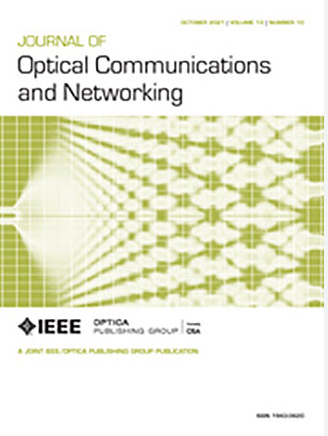High-performance system design for a large-scale AWG-based WDM star network
IF 4
2区 计算机科学
Q1 COMPUTER SCIENCE, HARDWARE & ARCHITECTURE
引用次数: 0
Abstract
Single-hop arrayed waveguide grating (AWG)-based wavelength division multiplexing (WDM) networks have attracted considerable attention in next-generation networks, especially due to their capability to support a large number of nodes within metropolitan areas. However, due to the static-wavelength-routing properties (non-broadcast nature) of AWG equipment, multiple copies of control information in the reservation-based medium access control (MAC) scheme must be sent to all output ports of the AWG device. Consequently, the control overhead becomes more severe, especially for large-scale networks such as data center networks. In this paper, we propose an AWG-node-connection network architecture that is capable of dividing all nodes into基于awg的大规模WDM星型网络的高性能系统设计
基于单跳阵列波导光栅(AWG)的波分复用(WDM)网络在下一代网络中引起了广泛的关注,特别是由于其在城域网内支持大量节点的能力。然而,由于AWG设备的静态波长路由特性(非广播性质),在基于预留的MAC (medium access control)方案中,必须向AWG设备的所有输出端口发送多份控制信息。因此,控制开销变得更加严重,特别是对于大型网络,如数据中心网络。在本文中,我们提出了一种AWG节点连接网络架构,该架构能够在星形网络的中心使用${D \ × D}$ AWG设备将所有节点划分为$D$自竞争子组。通过采用这种分组方法,我们的方案将控制开销降低到以前传统方法的${1/D}$,从而显着提高了系统性能。我们进一步提出了一种MAC协议,旨在解决连接到AWG不同输入输出端口的节点之间的争用,最大限度地提高空间重用,确保点对点传输,重要的是提高系统吞吐量。此外,我们提出的方案具有简单的拓扑结构和简单的硬件,使其适用于大型网络,如数据中心网络。仿真和分析结果表明,随着节点数量的增加,所提出的MAC方案在大范围的流量负载和不同的系统参数下都能获得优异的系统性能。
本文章由计算机程序翻译,如有差异,请以英文原文为准。
求助全文
约1分钟内获得全文
求助全文
来源期刊
CiteScore
9.40
自引率
16.00%
发文量
104
审稿时长
4 months
期刊介绍:
The scope of the Journal includes advances in the state-of-the-art of optical networking science, technology, and engineering. Both theoretical contributions (including new techniques, concepts, analyses, and economic studies) and practical contributions (including optical networking experiments, prototypes, and new applications) are encouraged. Subareas of interest include the architecture and design of optical networks, optical network survivability and security, software-defined optical networking, elastic optical networks, data and control plane advances, network management related innovation, and optical access networks. Enabling technologies and their applications are suitable topics only if the results are shown to directly impact optical networking beyond simple point-to-point networks.

 求助内容:
求助内容: 应助结果提醒方式:
应助结果提醒方式:


